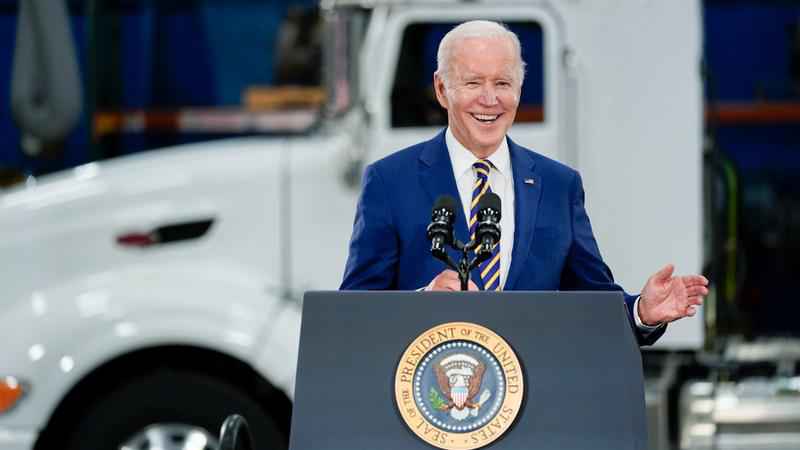In first visit to Minnesota as president, Biden puts focus on infrastructure amid new virus concerns
[anvplayer video=”5074591″ station=”998122″]
President Joe Biden on Tuesday went to Minnesota to pitch his completed infrastructure deal an a giant social spending bill that he’s still trying to get passed, but also found himself reassuring the nation he would fight the evolving COVID-19 threat without resorting to “shutdowns and lockdowns.”
Biden met with students at Dakota County Technical College in Rosemount in a garage space with a bulldozer, backhoe and cargo truck before delivering a speech criticizing GOP lawmakers for opposing his social services and climate spending bill that would expand health care coverage, enhance job training for students at community colleges, and offer child care benefits for middle and low income Americans.
Biden has been eager to build momentum for his agenda, but he finds himself once again forced to divert attention to battling the virus—this time because of global concerns about the spread of the omicron strain of the virus.
“This new variant is a cause of concern, but not a cause to panic,” Biden said.

President Joe Biden speaks at Dakota County Technical College, in Rosemount, Minn., Tuesday, Nov. 30, 2021. [AP Photo/Carolyn Kaster]
He said that on Thursday, he would detail his plan for how “we’re going to fight COVID this winter, not with shutdowns and lockdowns” but “with more widespread vaccination, boosters, testing and much more.”
Biden came to the suburban Minneapolis tech college looking to tout his $1 trillion infrastructure plan and making the case for an addition $1.75 trillion spending bill, which he is still trying to get through the Senate. The legislation includes $5 billion for community colleges to expand workforce training programs.
President Biden making pitch for Senate to pass $1.75T Build Back Better bill many Republicans say is fiscally irresponsible. Biden says it will be paid for by collecting taxes from major corporations that pay no taxes. Also says no one who earns under $400K will pay more taxes. pic.twitter.com/o3MYbF2OE2
— Tom Hauser (@thauserkstp) November 30, 2021
“Technology moves so rapidly,” Biden told students. “You’ve got to get an education to make it work.”
The trip came as Biden, who in addition to facing the threat of the new omicron strain of the coronavirus is also batting high levels of inflation as vital parts of his agenda are still await congressional approval. Biden also needs to get Congress to move to temporarily fund the government and preserve its ability to borrow as the debt limit could be breached in December.
[anvplayer video=”5074559″ station=”998122″]
Biden holds out the infrastructure package, containing money for roads, bridges, broadband, water systems and a shift to electrical vehicles, as evidence that he can work across the political aisle. The measure passed with solid Republican support.
Biden won Minnesota in last year’s presidential election with 52.6% of the vote. He’s visited the state’s second congressional district, a potentially vulnerable seat in the midterms that narrowly went to Democratic Rep. Angie Craig in 2020.
The president noted that Minnesotans saw first-hand the need to invest in rebuilding the nation’s infrastructure in August 2007 when a portion of the I-35 bridge in Minneapolis collapsed, killing 13 and injuring more than 140 more.
“No more talking, time for action,” Biden said. “This law makes significant investments in our roads and bridges.′
Biden says students at DCTC will help rebuild our infrastructure that was once rated the best in the world. Now ranked 13th by one source. Says 35W bridge collapse in Mpls one example of our crumbling infrastructure. pic.twitter.com/EgX4E6qpzk
— Tom Hauser (@thauserkstp) November 30, 2021
The president has recently been in close contact with the heads of several major retailers, including Target, which is headquartered in the state, as he attempts to resolve supply chain challenges that have clogged ports and caused consumers to wait longer for electronics, furniture and other goods.
The supply chain challenges have contributed to prices in October rising 6.2% from 12 months ago, the highest pace in 31 years. The White House National Economic Council issued a report Monday suggesting that there has been progress on addressing the problems, with a decrease in long-dwelling containers waiting at ports and an increase in retail inventories.
[anvplayer video=”5074463″ station=”998122″]